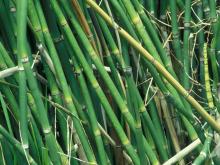Wildflowers, Grasses and Other Nonwoody Plants
Media

Species Types
Scientific Name
Equisetum (3 spp. in Missouri)
Description
Horsetails, or scouring rushes, are in the genus Equisetum. They’re easy to recognize with their jointed, hollow stems. Like ferns, they reproduce via spores instead of flowers and seeds.
Media

Species Types
Scientific Name
Adiantum spp. (2 in Missouri)
Description
Maidenhair ferns are distinctive and beautiful. Their leaflet veins divide by twos over and over, forming a fan pattern.
Media

Species Types
Scientific Name
Asplenium rhizophyllum (syn. Camptosorus rhyzophyllus)
Description
One of Missouri’s most distinctive ferns, walking fern walks. Its long, triangular leaves take root at the elongated tips, forming new plantlets.
Media

Species Types
Scientific Name
Botrypus virginianus (syn. Botrychium virginianum)
Description
Rattlesnake fern rises from the ground with a single stalk. A lacy-cut, bright green fern leaf is stalkless at its tip. At the same joint, a single upright stalk arises that bears clusters of tiny ball-shaped spore cases.
See Also
About Wildflowers, Grasses and Other Nonwoody Plants in Missouri
A very simple way of thinking about the green world is to divide the vascular plants into two groups: woody and nonwoody (or herbaceous). But this is an artificial division; many plant families include some species that are woody and some that are not. The diversity of nonwoody vascular plants is staggering! Think of all the ferns, grasses, sedges, lilies, peas, sunflowers, nightshades, milkweeds, mustards, mints, and mallows — weeds and wildflowers — and many more!





















